General H-class photos

U.S. Navy photo.
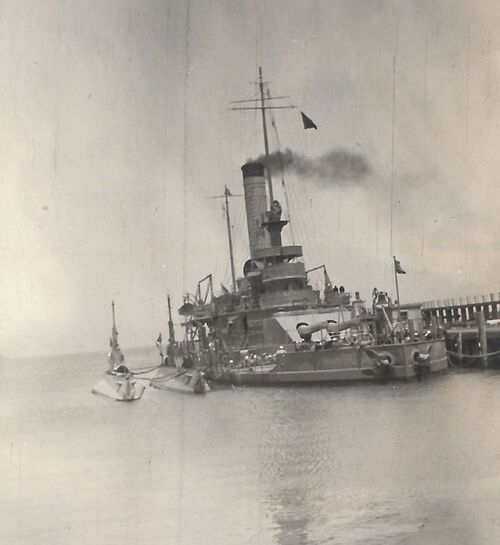
H-1 and H-2 moored alongside the USS Cheyenne (Monitor No. 10) at the Panama-Pacific Exposition in San Francisco, summer 1915. The old monitor was acting as a tender for the H-boats, her low freeboard making her an ideal ship to tend to the small submarines.
Photo in the private collection of Ric Hedman.
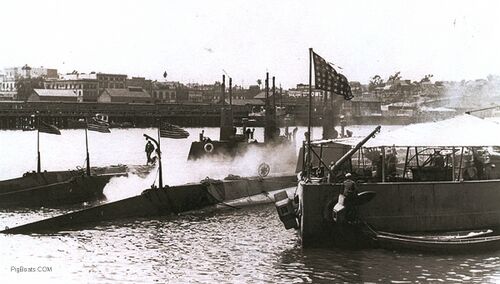
In this photo are the H-3, the H-1, and the H-2 moored to the starboard side of the USS Cheyenne (Monitor No. 10), circa 1915. The H-1 is running her starboard or #1 diesel engine. She is either putting in a battery charge or perhaps getting ready to get underway. The waterfront is possibly San Diego or maybe San Pedro. The Cheyenne has an awning spread over her foredeck to help cool the ship's interior. A crewman is on the port anchor possibly chipping paint or painting it. Two small skiffs are moored to the same area.
U.S. Navy photo.

The bow of an unknown H-class submarine with four crew relaxing and snoozing on the deck. Photo taken on February 20, 1921.
The starboard "ear" of the bow mounted Y-tube listening device can be seen to the right of the seated man's clasped hands. In today's Navy these men would not be allowed on deck like this without non-slip shoes, life vests and harnesses attached to the submarine.
Photo in the private collection of Ric Hedman.
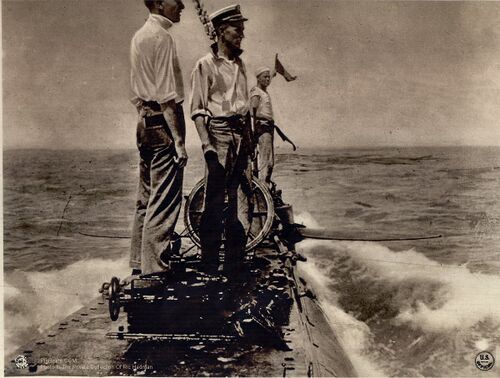
The foredeck of an H-class submarine. This has to be either the H-1, H-2 or H-3. The man all the way forward is standing on a circular deck structure that was only present on the four F-class subs and the first three of the H-class submarines, the following boats of the H-class did not have this feature. This is the large rotating gear needed to swing out the bow planes from their housed position. Also, the anchor windless, seen in the foreground, is aft of the torpedo room access hatch, which is open. On the F-class the windless was forward of the hatch.
It appears that maybe the Captain and one of his officers are standing on the deck reading messages being received from another vessel. The man using the signal flags is making the flag sign for the letter "W".
Note that the Bow planes are fully extended or "Rigged Out".
Photo in the private collection of Ric Hedman.

H-2 and the H-1 alongside the monitor USS Cheyenne, Feb. 22, 1917. All three vessels have dressed ship to celebrate George Washington's Birthday. Location is thought to be San Pedro. Both submarines left for the east coast for WW I operations in November of 1917. Only H-2 would survive the trip back to California in 1920. The H-1 would be lost on the beach on Santa Margarita Island, Baja California, Mexico, on March 12, 1920 with the loss of 4 lives.
Photo in the private collection of Ric Hedman.
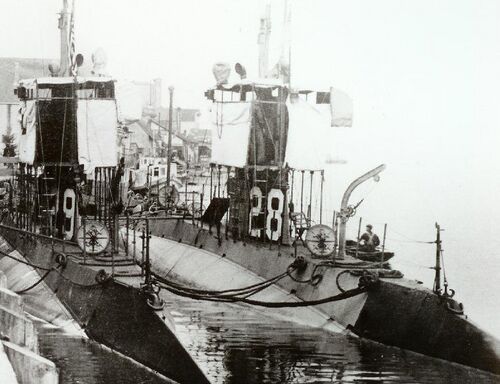
USS H-1 & H-2 moored together in Coos Bay, Oregon. They were the first submarines to visit the Oregon town. Circa 1917.
Photo courtesy of MMCM(SS) Rick Larson, USN (Ret.).
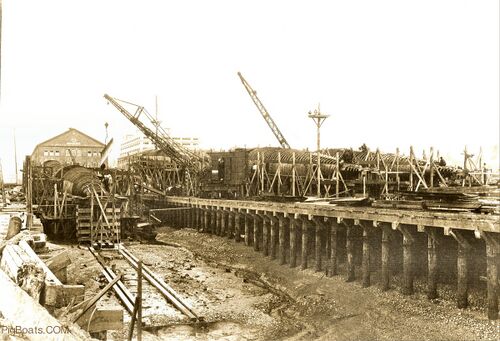
This image shows the six Canadian built H-Boats undergoing reconstruction at the Puget Sound Navy Yard in July of 1918. The submarines were laid down between May 12 and June 1, 1918. You can see how quickly the assembly process was progressing.
They were all launched and commissioned between August and November of 1918. The first to go was the H-6 being launched on August 26, 1918. The next to hit the water was the H-5 with her launch on September 26th. The H-4 was third on October 9th, followed by H-7 on October 17th. This cleared the raised ways on the dock. Fifth was the H-8 on November 14th and H-9 on November 23, 1918. Around six months construction time to build six submarines!
The vessels had originally been contracted by the Imperial Russian government. Unable to get around export restrictions during WWI, Electric Boat contracted with the Vickers shipyard in Vancouver, B.C. to build the boats. They would then be disassembled for shipment to Vladivostok, Russia, then loaded on the Trans-Siberian Railroad for shipment to a Russian facility on the Baltic for reassembly. The boats were built, completed, and ready to go in knock down form when the Russian Revolution broke out and the shipment was canceled until the outcome of the revolution was known. With the success of the Bolsheviks the sale was canceled as the contract was signed with Tsarist Russia.
The U.S. Navy stepped in and bought the six submarines since the U.S. was involved in WW I and all the subs she could acquire were needed. The partially disassembled vessels were transported from Vancouver to the Puget Sound Navy Yard in Bremerton, Washington, a distance of barely over 120 miles and were quickly sorted and building ways set up.
According to a diagram discovered in reference documents gathered by submarine author Bill Lightfoot, author of Beneath the Surface, WWI Submarines Built in Seattle and Vancouver, the vessels seen in this photo are, starting from the left rear to forward, are the H-9 and the H-8. The submarine behind the crane boom is the H-7 with the H-6 in the center foreground. The submarine on the right is the H-5. Unseen in the photo is the H-4 behind the H-5. The H-6 and the cab of the crane is blocking the view of the H-4.
The crane is in the process of lifting a hull plate into position to be riveted to the H-8 hull frames. There is already one plate on the port side of the hull about the location of the engine room. This might be the matching plate for the starboard side. All parts were cut and formed in Canada and just needed to be fit into place and fastened. It made for quick assembly.
Lower hull plating has been applied to the H-7, H-6, and H-5. It can only be assumed that the same is true for the H-9 and H-4 as the angle of the photo doesn't allow us to see those boats or see them clearly.
Photo negative in the private collection of Ric Hedman.

All six of the former Russian H-boats in frame at Puget Sound Navy Yard. H-4 thru H-9 were shipped from Canada in crates and assembled at the same time at Bremerton. Only four of the boats are visible in this photo. The H-4 at far right with the H-5 in right center foreground and to the left of the H-5 is the H-6. To the left of the H-4 is the H-7.
The subs were built, then disassembled and crated, and were to be shipped to Vladivostok and eventually by train across Russia for reassembly on the Baltic. The U.S. bought them for addition to the Navy for WW I. Essentially these were huge "kit boats", they just had to be assembled.
Barely visible under the crane boom on the left is the almost completed hull of the USS O-2 (SS-63), another EB design boat built under license at this yard.
Original photo from the National Archives.
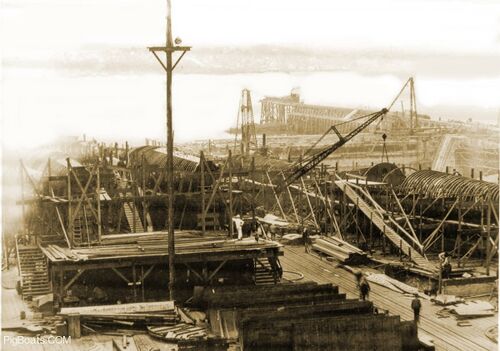
This view of the Puget Sound Navy Yard in Bremerton is looking southwest across Sinclair Inlet, towards the city of Port Orchard, Washington, late summer of 1918. On the right is the H-9 with the H-8 in front of it towards the water. The submarine bisected by the pole is the H-7 with the H-6 in front of her. To the left is the H-4 and completely unseen in the white glare is the H-5.
Photo negative in the private collection of Ric Hedman.
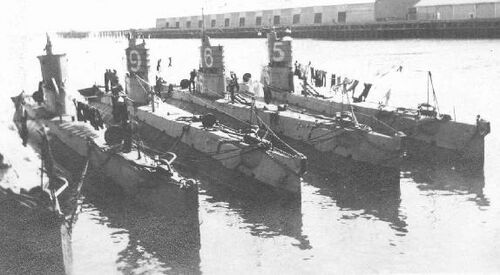
Two unknown H-class, H-9, H-6, and H-5 moored at Submarine Base San Pedro in 1919. Unlike today, the Port of San Pedro was a busy base for the U.S. Navy during the interwar period. A Navy yard and repair facility was never established, but a Submarine Base was in place along with logistical support facilities for a fleet anchorage offshore.
Photo provided by Stan Lintner. His father, Harold Lintner, served aboard the H-8 as a Chief Electricians Mate.
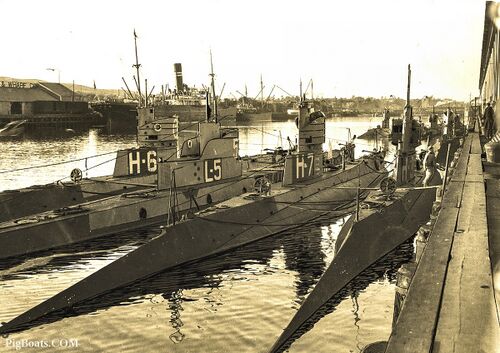
This photo was sent to us as it appears on the Los Angeles Water & Power web site. The photo appeared in the LA Times on February 20, 1920.
In the fore ground, left to right are the H-7, L-5 (SS-44), H-6, and the H-3. In the second row is just the H-4. The image is a little fuzzy but a "4" just barely visible. In the third row is the H-5. The H-3 bridge structure is blocking whatever may be the next submarine. To the right of that it looks to be another L-class submarine and lastly it is quite possibly another H-class sub.
All of the H-boats in this photo, with the exception of the H-3, were originally constructed in Vancouver, Canada for the Tsarist Russian Navy. But when the Russia Revolution happened they were never shipped. The United States bought them and built them at Bremerton, Washington. Their hull numbering falls in the middle of the S-class sequences.
US Navy photo contributed by Darryl Baker from the Los Angeles Water & Power web site.

Crew standing and sitting on the conning tower fairwater on what is most likely one of the first three H-class submarines. The smooth sides of the chariot bridge and the flare on both the top of the bridge and the top of the fairwater conform to features seen on at least one of the early H-Class submarines.
Note the capped off flange structure in the foreground, especially the bolt pattern. The sub's gangplank is on the deck on the left. Photo circa February 20, 1921.
Photo in the private collection of Ric Hedman.
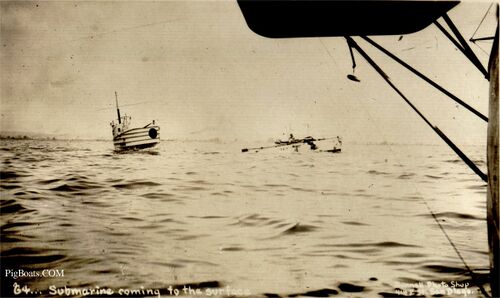
An unknown H-class submarine surfacing off San Pedro (Los Angeles), California, early 1920's. Submarines would first come to periscope depth for a look around to ensure safety prior to surfacing. They would then blow the forward ballast tanks and place the diving planes on rise. This forces the bow to the surface, and once it has broken the water the aft group ballast tanks are blown to raise the stern. Once stability on the surface is obtained, a low-pressure blow is put on the ballast tanks to fully empty them of water and to restore normal surface trim.
Photo in the private collection of Ric Hedman.
Page created by:
Ric Hedman & David Johnston
1999 - 2023 - PigBoats.COM©
Mountlake Terrace, WA, Norfolk, VA
webmaster at pigboats dot com
